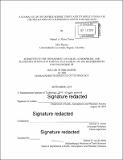| dc.contributor.advisor | German A. Prieto. | en_US |
| dc.contributor.author | Florez Torres, Manuel Alberto. | en_US |
| dc.contributor.other | Massachusetts Institute of Technology. Department of Earth, Atmospheric, and Planetary Sciences. | en_US |
| dc.date.accessioned | 2020-02-10T21:39:46Z | |
| dc.date.available | 2020-02-10T21:39:46Z | |
| dc.date.copyright | 2019 | en_US |
| dc.date.issued | 2019 | en_US |
| dc.identifier.uri | https://hdl.handle.net/1721.1/123736 | |
| dc.description | Thesis: Ph. D., Massachusetts Institute of Technology, Department of Earth, Atmospheric, and Planetary Sciences, 2019 | en_US |
| dc.description | Cataloged from PDF version of thesis. | en_US |
| dc.description | Includes bibliographical references (pages 91-105). | en_US |
| dc.description.abstract | The fundamental physical processes to generate earthquakes contradict the occurrence of intermediate-depth (80-350 km) seismicity: both pressure and temperature increase with depth, which inhibits fracture, unstable sliding, and promotes ductile flow. Classic experiments on olivine, the main mineral that composes the mantle, show that the shear stresses necessary to overcome the high normal stresses imposed by the overburden pressure are unsustainable at these depths. In subduction zones, the dehydration of the descending oceanic lithosphere might enable the observed brittle-like behavior; but this hypothesis remains controversial, as there are other viable alternatives. Improving our understanding of the intermediate-depth seismicity relies on assembling accurate and systematic seismological observations, which I tackle here in my graduate work. First, I developed a relocation method that uses array processing in such a way that velocity model biases are reduced. | en_US |
| dc.description.abstract | The technique identifies and picks the arrival of depth phases and perform a relative relocation scheme. When high-quality data is available, hypocentral depth can be estimated with a precision of a few kilometers. I systematically applied this technique to build a new global catalog of intermediate depth seismicity. At depths larger than about 50 km, most subducting slabs feature two distinct layers of seismicity, known as Double Seismic Zones (DSZ). I used my relocated catalog to characterize 32 slab segments, sampling a diverse range of tectonic environments. I was able to clearly resolve the geometrical structure of DSZs and to separately study subducting crust (upper layer) and lithospheric mantle (lower layer) earthquakes. | en_US |
| dc.description.abstract | I performed a careful analysis of the frequency-size statistics for each layer, finding consistently larger b-values (proportion of low-to-high magnitude events), correlating with slab age, for the upper plane of the lithosphere while a roughly constant values for the lower plane. Provided that b-values are indicative of stress regime, this suggests a different mechanism for earthquakes happening in the upper and in the lower plan of the subducting oceanic lithosphere. | en_US |
| dc.description.statementofresponsibility | by Manuel A. Florez Torres. | en_US |
| dc.format.extent | 105 pages | en_US |
| dc.language.iso | eng | en_US |
| dc.publisher | Massachusetts Institute of Technology | en_US |
| dc.rights | MIT theses are protected by copyright. They may be viewed, downloaded, or printed from this source but further reproduction or distribution in any format is prohibited without written permission. | en_US |
| dc.rights.uri | http://dspace.mit.edu/handle/1721.1/7582 | en_US |
| dc.subject | Earth, Atmospheric, and Planetary Sciences. | en_US |
| dc.title | A global study of double seismic zones and its implications for the mechanism of intermediate-depth earthquakes | en_US |
| dc.type | Thesis | en_US |
| dc.description.degree | Ph. D. | en_US |
| dc.contributor.department | Massachusetts Institute of Technology. Department of Earth, Atmospheric, and Planetary Sciences | en_US |
| dc.identifier.oclc | 1138877644 | en_US |
| dc.description.collection | Ph.D. Massachusetts Institute of Technology, Department of Earth, Atmospheric, and Planetary Sciences | en_US |
| dspace.imported | 2020-02-10T21:39:46Z | en_US |
| mit.thesis.degree | Doctoral | en_US |
| mit.thesis.department | EAPS | en_US |
